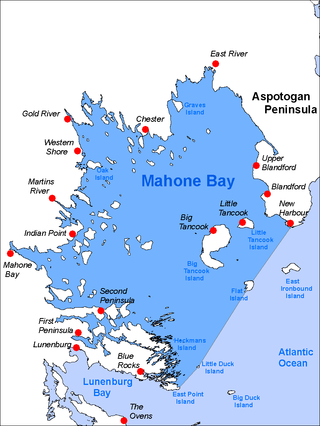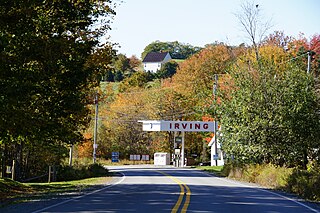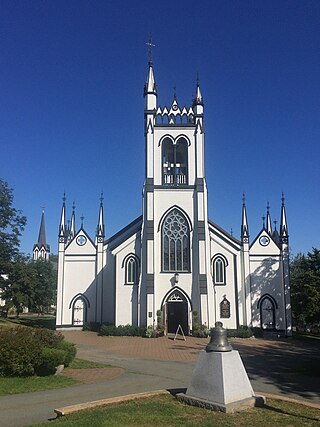First Peninsula is a community in the Canadian province of Nova Scotia, located in the Lunenburg Municipal District in Lunenburg County.
Coordinates: 44°22′58.84″N64°18′55.22″W / 44.3830111°N 64.3153389°W
First Peninsula is a community in the Canadian province of Nova Scotia, located in the Lunenburg Municipal District in Lunenburg County.
Coordinates: 44°22′58.84″N64°18′55.22″W / 44.3830111°N 64.3153389°W

Mahone Bay is a bay on the Atlantic coast of Nova Scotia, Canada along the eastern end of Lunenburg County. The bay has many islands, and is a popular sailing area. Since 2003 the Mahone Islands Conservation Association has been working to protect the natural environment of the bay. The bay and its islands contain a variety of habitats including forests, rocky shores, beaches, wetlands, and mudflats. Wildlife in the area include black guillemots, eagles, osprey, leach's storm petrels, puffins, razorbills, and great blue herons.
The Aspotogan Peninsula is a peninsula in the eastern part of Lunenburg County, Nova Scotia, separating St. Margarets Bay in the east from Mahone Bay in the west. The peninsula was originally settled by second generation French immigrants on the east side and by second generation German immigrants on the west side. Traditionally fishing was a major industry for communities throughout the peninsula, however other primary industries such as farming and forestry were historically important as well. Shipping and shipbuilding were secondary and tertiary industries that also came into prominence during the 19th and early 20th centuries.
Mill Cove is a community in the Canadian province of Nova Scotia, located in the Chester Municipal District on the Aspotogan Peninsula on the Lighthouse Route. The community was home to CFS Mill Cove from 1967 til the 1990s.

Newcombville is a community in the Canadian province of Nova Scotia, located in the Lunenburg Municipal District in Lunenburg County 11 kilometers or seven miles from Bridgewater-the county service center on the shores of the LaHave River.
Blockhouse is a community in the Canadian province of Nova Scotia, located in the Lunenburg Municipal District in Lunenburg County. It was named after the blockhouses constructed by Captain Ephraim Cook to protect colonists following a raid in 1756. The final blockhouse in the community burned down in 1874.
Wileville is a community in the Canadian province of Nova Scotia, located in the Lunenburg Municipal District in Lunenburg County.
Dayspring is a community in the Canadian province of Nova Scotia, located on the banks of the Lahave River in the Lunenburg Municipal District in Lunenburg County. It is home to the traditional wooden shipyard, Snyder's Shipyard, builders of Theodore Too, among many other vessels, as well as The Riverview Enhanced Living Centre, Miller's Point Peace Park, the Municipal Activity and Recreation Complex and the Bridgewater/Dayspring Airpark.
Rhodes Corner is a community in the Canadian province of Nova Scotia, located in the Lunenburg Municipal District in Lunenburg County.
Cherry Hill is a community in the Canadian province of Nova Scotia, located in the Lunenburg Municipal District in Lunenburg County.
Pentz is a rural community in the Canadian province of Nova Scotia, located in the Lunenburg Municipal District in Lunenburg County.
Dublin Shore is a community in the Canadian province of Nova Scotia, located in the Lunenburg Municipal District in Lunenburg County. It takes its name from Dublin, Ireland.
Broad Cove is a community in the Canadian province of Nova Scotia, located in the Lunenburg Municipal District in Lunenburg County.
Back Centre is a community in the Canadian province of Nova Scotia, located in the Lunenburg Municipal District in Lunenburg County.
Heckman's Island is a community in the Canadian province of Nova Scotia, located in the Lunenburg Municipal District in Lunenburg County. After Mi'kmaq fighters killed John Payzant's father and brother in the Raid on Lunenburg (1756), they were buried on Heckman's Island.
Second Peninsula is a community in the Canadian province of Nova Scotia, located in the Lunenburg Municipal District in Lunenburg County.

The Raid on Lunenburg occurred during the French and Indian War when Mi'kmaq and Maliseet fighters attacked a British settlement at Lunenburg, Nova Scotia on May 8, 1756. The native militia raided two islands on the northern outskirts of the fortified Township of Lunenburg, Rous Island, and Payzant Island. According to French reports, the Raiding party killed twenty settlers and took five prisoners. This raid was the first of nine the Natives and Acadians would conduct against the peninsula over a three-year period during the war. The Wabanaki Confederacy took John Payzant and Lewis Payzant prisoner, both of whom left written account of their experiences.
Southwest Cove is a Canadian rural community located in Lunenburg County, Nova Scotia.

St. John's Anglican Church was the first church established in Lunenburg, Nova Scotia, Canada (1753). It is the second Church of England built in Nova Scotia, and is the second oldest continuous Protestant church in present-day Canada. Early on 1 November 2001, St. John's church suffered significant damage by fire. It was restored and re-dedicated June 12, 2005.

St. Andrew's Presbyterian Church is a church in Lunenburg, Nova Scotia. The congregation is the longest history of any Presbyterian congregation in Canada. After meeting at a private house, the congregation worshipped in St. John's Anglican Church (Lunenburg) (1759-1770). The first church was built in 1770 and the first minister was Reverend Bruin Romkes Comingo, who served the community for 50 years until he died at age 95 (1820). The current church was built in the neo-gothic style and dates from 1828.
The Hillcrest Cemetery is the oldest protestant cemetery in Lunenburg, Nova Scotia and one of the oldest in Canada. The cemetery is adjacent to the Lunenburg Academy. The oldest marker is dated 1761, eight years after Lunenburg was established. Hillcrest Cemetery contains 5 Commonwealth war graves from World War I and one from World War II.